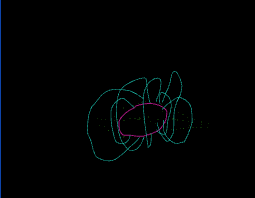Coding project idea #three.js
So I am starting to really understand JavaScript html and css I have been learning it ever since I was in 5th grade (I’m in 10th grade now) and I have some ideas for projects that I would like to share with y’all and get your feedback/help with So my first idea is a galactic event I really want to create a simulation for a galactic event and make it look as realistic as possible an Idea I am thinking about currently is a black hole I have done tons and tons of research and read through dozens and dozens of documents about black holes just to get an idea of how I would need to code it I would like to attempt to code a schwarzschild black hole but am not quite sure how to start I will definitely be thinking about how I would start it but that’s not the only thing about this project idea, what about making it look realistic so I have looked at every article every document every NASA picture every picture claiming to be a black hole and I have learned something that I kind of feared… its a black hole dude you cant see it so I’m wondering if I should make it as a bunch of colored dots to show whats actually happening kind of like this quick sketch I made but with a lot more presition and detail and way more dots XD I want to do this with Three.js that way I can make it 3D and use shaders I need to use GLSL shaders for the design of it but don’t know how to use them (if you know how to use them or know someone who knows how to use them please send/tell them to send me a message) I expect this project will take a few months at best and I would love to work with some of you on it I would love to get to know y'all and to work with all of you on this project Here are all the sources I have gathered Source reference http://spiro.fisica.unipd.it/~antonell/schwarzschild/ http://rantonels.github.io/starless/ https://github.com/oseiskar/black-hole Related physics and maths GR and blackhole https://en.wikipedia.org/wiki/Schwarzschild_geodesics https://en.wikipedia.org/wiki/Schwarzschild_metric#Singularities_and_black_holes https://en.wikipedia.org/wiki/Christoffel_symbols#Christoffel_symbols_of_the_first_kind https://en.wikipedia.org/wiki/Spherical_coordinate_system https://en.wikipedia.org/wiki/Killing_vector_field https://www.physicsforums.com/threads/what-is-a-time-like-killing-vector.40565/ https://physics.stackexchange.com/questions/39124/what-is-a-killing-vector-field https://en.wikipedia.org/wiki/Metric_tensor_(general_relativity) Circular Orbit https://en.wikipedia.org/wiki/Angular_velocity#Particle_in_two_dimensions https://en.wikipedia.org/wiki/Angular_momentum#Angular_momentum_in_orbital_mechanics https://en.wikipedia.org/wiki/Circular_orbit#Orbital_velocity_in_general_relativity https://en.wikipedia.org/wiki/Aberration_of_light https://en.wikipedia.org/wiki/Lorentz_transformation stellar color change "Relativistically moving objects are beamed due to a variety of physical effects. Light aberration causes most of the photons to be emitted along the object's direction of motion. The Doppler effect changes the energy of the photons by red- or blueshifting them. Finally, time intervals as measured by clocks moving alongside the emitting object are different from those measured by an observer on Earth due to time dilation and photon arrival time effects. How all of these effects modify the brightness, or apparent luminosity, of a moving object is determined by the equation describing the relativistic Doppler effect (which is why relativistic beaming is also known as Doppler beaming)" https://en.wikipedia.org/wiki/Gravitational_redshift https://en.wikipedia.org/wiki/Relativistic_Doppler_effect#math_5 https://en.wikipedia.org/wiki/Relativistic_beaming https://physics.stackexchange.com/questions/227738/time-dilation-equals-red-shift-looking-in-or-blue-shift-looking-out beaming - luminosity doppler - wavelength change blueshift from observer movement redshift from stellar movement the thing is, we don't know any information from static background texture, so applying doppler effect does not make any sense. temperature to color https://docs.kde.org/trunk5/en/extragear-edu/kstars/ai-colorandtemp.html http://www.tannerhelland.com/4435/convert-temperature-rgb-algorithm-code/ Projection http://paulbourke.net/geometry/transformationprojection/

So I am starting to really understand JavaScript html and css I have been learning it ever since I was in 5th grade (I’m in 10th grade now) and I have some ideas for projects that I would like to share with y’all and get your feedback/help with
So my first idea is a galactic event I really want to create a simulation for a galactic event and make it look as realistic as possible an Idea I am thinking about currently is a black hole I have done tons and tons of research and read through dozens and dozens of documents about black holes just to get an idea of how I would need to code it I would like to attempt to code a schwarzschild black hole but am not quite sure how to start I will definitely be thinking about how I would start it
but that’s not the only thing about this project idea, what about making it look realistic so I have looked at every article every document every NASA picture every picture claiming to be a black hole and I have learned something that I kind of feared… its a black hole dude you cant see it
so I’m wondering if I should make it as a bunch of colored dots to show whats actually happening kind of like this quick sketch I made but with a lot more presition and detail and way more dots XD
I want to do this with Three.js that way I can make it 3D and use shaders I need to use GLSL shaders for the design of it but don’t know how to use them (if you know how to use them or know someone who knows how to use them please send/tell them to send me a message)
I expect this project will take a few months at best and I would love to work with some of you on it
I would love to get to know y'all and to work with all of you on this project
Here are all the sources I have gathered
Source reference
http://spiro.fisica.unipd.it/~antonell/schwarzschild/
http://rantonels.github.io/starless/
https://github.com/oseiskar/black-hole
Related physics and maths
GR and blackhole
- https://en.wikipedia.org/wiki/Schwarzschild_geodesics
- https://en.wikipedia.org/wiki/Schwarzschild_metric#Singularities_and_black_holes
- https://en.wikipedia.org/wiki/Christoffel_symbols#Christoffel_symbols_of_the_first_kind
- https://en.wikipedia.org/wiki/Spherical_coordinate_system
- https://en.wikipedia.org/wiki/Killing_vector_field
- https://www.physicsforums.com/threads/what-is-a-time-like-killing-vector.40565/
- https://physics.stackexchange.com/questions/39124/what-is-a-killing-vector-field
- https://en.wikipedia.org/wiki/Metric_tensor_(general_relativity)
Circular Orbit
- https://en.wikipedia.org/wiki/Angular_velocity#Particle_in_two_dimensions
- https://en.wikipedia.org/wiki/Angular_momentum#Angular_momentum_in_orbital_mechanics
- https://en.wikipedia.org/wiki/Circular_orbit#Orbital_velocity_in_general_relativity
- https://en.wikipedia.org/wiki/Aberration_of_light
- https://en.wikipedia.org/wiki/Lorentz_transformation
stellar color change
"Relativistically moving objects are beamed due to a variety of physical effects. Light aberration causes most of the photons to be emitted along the object's direction of motion. The Doppler effect changes the energy of the photons by red- or blueshifting them. Finally, time intervals as measured by clocks moving alongside the emitting object are different from those measured by an observer on Earth due to time dilation and photon arrival time effects. How all of these effects modify the brightness, or apparent luminosity, of a moving object is determined by the equation describing the relativistic Doppler effect (which is why relativistic beaming is also known as Doppler beaming)"
- https://en.wikipedia.org/wiki/Gravitational_redshift
- https://en.wikipedia.org/wiki/Relativistic_Doppler_effect#math_5
- https://en.wikipedia.org/wiki/Relativistic_beaming
- https://physics.stackexchange.com/questions/227738/time-dilation-equals-red-shift-looking-in-or-blue-shift-looking-out
beaming - luminosity
doppler - wavelength change
blueshift from observer movement
redshift from stellar movement
the thing is, we don't know any information from static background texture,
so applying doppler effect does not make any sense.
temperature to color
- https://docs.kde.org/trunk5/en/extragear-edu/kstars/ai-colorandtemp.html
- http://www.tannerhelland.com/4435/convert-temperature-rgb-algorithm-code/









































































































































































![[The AI Show Episode 142]: ChatGPT’s New Image Generator, Studio Ghibli Craze and Backlash, Gemini 2.5, OpenAI Academy, 4o Updates, Vibe Marketing & xAI Acquires X](https://www.marketingaiinstitute.com/hubfs/ep%20142%20cover.png)


























































































































![[FREE EBOOKS] The Kubernetes Bible, The Ultimate Linux Shell Scripting Guide & Four More Best Selling Titles](https://www.javacodegeeks.com/wp-content/uploads/2012/12/jcg-logo.jpg)



![From drop-out to software architect with Jason Lengstorf [Podcast #167]](https://cdn.hashnode.com/res/hashnode/image/upload/v1743796461357/f3d19cd7-e6f5-4d7c-8bfc-eb974bc8da68.png?#)







































































































.png?#)




.jpg?#)


















 (1).webp?#)













_Christophe_Coat_Alamy.jpg?#)







































































































![Rapidus in Talks With Apple as It Accelerates Toward 2nm Chip Production [Report]](https://www.iclarified.com/images/news/96937/96937/96937-640.jpg)









































































































































